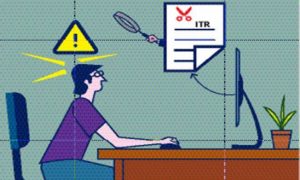The present ever-evolving and dynamic era demands adaptivity from the current youth. In order to harmonise in this VUCA world, they need to aspire to higher education. Higher education demands higher costs, thereby increasing the financial burden of both the parents and the students. In earlier times, the cost of higher education was borne by the parents who either funded the fees from their past savings or mortgaged/sold their assets. But as per finance experts, instead of depleting the assets or past savings which can be invested in lucrative investment opportunities, education loans can be sought from financial institutions.
Apart from instilling a financial responsibility on the students, education loan also comes with tax benefits. As per Section 80E of the Income Tax Act, 1962, any individual seeking an education loan can avail a deduction for the interest paid on the loan taken for eight consecutive years starting from the year of repayment. Furthermore, there is no ceiling on the amount of deduction for interest repayment. This reduces the tax liability of the seeker of education loan, thereby increasing the disposable income of the students in the initial period of their earnings.
The outburst of COVID-19 has taken a massive toll on the timely repayments of these education loans. Lockdown due to this pandemic has greatly impacted the cash flow of the businessman and consequently, the salaried class is also suffering from salary reduction and lay-off. Apart from these, the students and the current graduates are also grappling with their existing education loans due to the meagre employment opportunities. As a result of these adverse conditions, credit score of the borrowers have severely affected resulting into either delay or complete default in the EMIs (Equated monthly instalments) payments. A weak credit score will also have a negative impact on future borrowings prospects of loan applicants.
Not only the borrowers, even the bankers are also struggling to manage and mitigate the credit risks in this pandemic. They are striving hard to recover the money from the borrowers as per the stipulated timelines.
Amidst all these struggles, RBI had tried to ease the financial stress of both the borrowers and the bankers vide its circular DOR.No.BP.BC/3/21.04.048/2020-21 dated August 6, 2020 on “Resolution Framework for COVID-19-related Stress”. It gave an option to the borrowers to restructure their loan once without being classified as NPA (Non-Performing Asset). As per the guidelines, the loanee can either choose to merge their accrued interest with the principal amount or reschedule the payment timelines or seek for a moratorium for a maximum period of two years. Thus, the circular gives an opportunity to the borrowers for overall modification of their loan without affecting their creditability.
However, the new education loan seekers can manage the financial burden in different ways. For example, an education loan backed by adequate collateral i.e. property, land, FD, etc. entails a lower rate of interest. The lenders (bankers) are also relieved of the delinquency stress.
The period between the loan disbursement and the repayment of the same i.e grace period/ moratorium period is specially granted to the education loan seekers for the repayment of EMIs after the completion of the course or beginning of the earning cycle. However, the interest accrued during the moratorium period is added to the principal amount. Sometimes, the bankers offer a concession to the fund seekers who opt for payment of the interest accrued during the moratorium period itself. The availment of this concession will reduce the loan burden.
Often, the government also proposes concessions especially to the students belonging to weaker sections, females or even for premier institutes where job perspectives are brighter. Sometimes, the government even agrees to waive off the interest accrued during the moratorium period. The borrowers should be abreast of all these schemes and proceed with the loan procedure accordingly. Apart from these, a loanee can also plan the repayment schedule beforehand as per his financial capability to minimise the financial stress of EMIs.
Recently, University Grants Commission has also developed a portal “Vidya Lakshmi” for the students who seek to take an education loan under the guidance of the Ministry of Finance, Ministry of HRD and the Indian Banks Association. The basic aim of the portal is to assist the students in obtaining a hassle-free education loan upto Rs 7,50,000 for studies in India and Rs 15,00,000 for abroad. The students seeking a loan through this portal also gets a waiver of margin or collaterals for loans upto Rs 4,00,000. For the loan amount exceeding Rs 4,00,000, interest rate can be availed as per the prime lending rate (PLR). In addition to this, a grace period of one year after the completion of studies can also be opted for.
Thus, it can be concluded that with proper planning and strategy, financial stress related to education loans for higher education can be mitigated even in the current pandemic period.



































